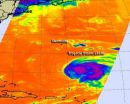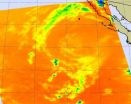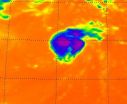(Press-News.org) CAMBRIDGE, MA -- Only about 1 percent of the human genome contains gene regions that code for proteins, raising the question of what the rest of the DNA is doing. Scientists have now begun to discover the answer: About 80 percent of the genome is biochemically active, and likely involved in regulating the expression of nearby genes, according to a study from a large international team of researchers.
The consortium, known as ENCODE (which stands for "Encyclopedia of DNA Elements"), includes hundreds of scientists from several dozen labs around the world. Using genetic sequencing data from 140 types of cells, the researchers were able to identify thousands of DNA regions that help fine-tune genes' activity and influence which genes are expressed in different kinds of cells.
Just as the sequencing of the human genome helped scientists learn how mutations in protein-coding genes can lead to disease, the new map of noncoding regions should provide some answers on how mutations in the regulatory elements lead to diseases such as lupus and diabetes, says Manolis Kellis, an associate professor of computer science at MIT, an associate member of the Broad Institute and an author of a paper describing the findings in the Sept. 5 online edition of Nature.
"Humans are 99.9 percent identical to each other, and you only have one difference in every 300 to 1,000 nucleotides," Kellis says. "What ENCODE allows you to do is provide an annotation of what each nucleotide of the genome does, so that when it's mutated, we can make some predictions about the consequences of the mutation."
Kellis, who leads MIT's Computational Biology Group, is one of the principal investigators involved in the Nature paper. The ENCODE collaboration is publishing about two dozen additional papers this week detailing the new results.
Mapping noncoding DNA
ENCODE was established in 2003 to extend our understanding of the human genome beyond protein-coding genes. One way to do that is by studying the chemical modifications of individual stretches of DNA, which control when genetic regions will be active. These modifications vary by cell type and can modify either DNA directly or the histone proteins that DNA wraps around.
To map these modifications, known collectively as the epigenome, the research groups had to collect many different kinds of data from different cell types. Some labs measured DNA or histone modifications, while others gauged the accessibility of different stretches of DNA by cutting it into fragments with enzymes.
Kellis and his group were among the computational scientists leading the effort to analyze and integrate the huge amount of data generated by different labs. "Given that we were getting more than 1,000 data sets, we had to figure out ways to automatically calibrate experiments," says Anshul Kundaje, a research scientist in MIT's Computational Biology Group. "We developed an almost purely automated system that did all of this."
The ENCODE researchers found that 80 percent of the genome experiences some kind of biochemical event, such as binding to proteins that regulate how often a neighboring gene is utilized. They also discovered that the same regulatory region can play different roles, depending on what type of cell it's acting in.
Human variation
The researchers also studied the conservation of nucleotides — the A, T, C and G "letters" of DNA — in the newly identified regulatory regions. Nucleotides are conserved if they remain the same over long evolutionary periods, which can be measured by analyzing the variability between species, or among individuals within a species.
A recent paper by Kellis and colleagues showed that 5 percent of noncoding DNA is conserved across mammals. In one of the ENCODE companion papers appearing online Sept. 5 in Science, Kellis and MIT postdoc Lucas Ward show that an additional 4 percent is conserved within the human lineage, suggesting that those elements control recently evolved traits, some of which are unique to humans.
When the researchers looked at the functions of genes near newly evolved regulatory regions, they found many genes that encode regulators that activate other genes. "Genes involved in the nerve growth pathway and color vision, both of which have been hypothesized to be recent innovations in the primate lineage, are enriched in human-constrained elements in non-conserved regions," Ward says.
The researchers found that the most highly conserved nucleotides were also the ones most likely to be associated with disease when mutated. They also showed that variants associated with autoimmune diseases such as lupus and rheumatoid arthritis are located in regions active only in immune cells, while variants linked to metabolic diseases are in regions active only in liver cells.
In their next phase, the ENCODE researchers hope to determine just how those variations lead to human disease.
"What we've done over this series of papers is effectively paint a set of reference annotations of common human genome function," Kellis says. "Our next steps will be to personalize these maps — to basically ask how they vary naturally between individuals, by profiling different cell types from different people, and how their variation relates to human disease and complex human traits."
In one follow-up project, Kellis and colleagues are comparing activity levels of regulatory elements in different cell types from the same person, across many individuals. Another project is looking at DNA modification patterns across the entire genome of many individuals, in hopes of identifying how variation of specific elements relates to disease.
###
The research was funded by the National Human Genome Research Institute.
Written by: Anne Trafton, MIT News Office
END
Infrared data from NASA's Aqua satellite shows that Tropical Storm Leslie has been causing problems for itself.
Tropical Storm Leslie has been on a slow track in the Atlantic, and because of that, the storm is kicking up cooler waters from below the ocean surface. Those cooler waters were seen in infrared imagery on Sept. 5 at 0611 UTC (2:11 a.m. EDT) taken by the Atmospheric Infrared Sounder (AIRS) instrument that flies aboard NASA's Aqua satellite. The cooler waters are responsible for Leslie's slow strengthening. Sea surface temperatures need to be at least as warm ...
Post-tropical cyclone John has been "flushed" out of existence in the eastern Pacific Ocean, and infrared NASA imagery revealed warmer cloud top temperatures and virtually no precipitation from John's remnants on Sept. 4.
When NASA's Aqua satellite flew over post-tropical storm John on Sept. 4 at 21:23 UTC (5:23 p.m. EDT) the Atmospheric Infrared Sounder (AIRS) instrument revealed that cloud top temperatures in the storm had warmed over the previous 24 hours. AIRS data also showed there was one very tiny area of convection (rising air that forms the thunderstorms that ...
For years policymakers have attempted to replace Medicare's fee-for- service payment system with approaches that pay one price for an aggregation of services. The intent has been to reward providers for offering needed care in the most appropriate and cost-effective manner. But many of these programs have known pitfalls, says Stuart Altman, an economist and the Sol C. Chaikin Professor of National Health Policy at the Heller School for Social Policy and Management, Brandeis University.
On Friday, Sept. 7, Altman and his Heller school colleague Robert Mechanic, will ...
NASA's Aqua satellite shows that tiny Tropical Storm Michael had some strong thunderstorms wrapped around its center and in a band of thunderstorms in its northeastern "arm" or quadrant.
The Atmospheric Infrared Sounder (AIRS) instrument that flies aboard NASA's Aqua satellite captured in infrared image of Tropical Storm Michael on Sept. 5 at 0611 UTC (2:11 a.m. EDT) and noticed the strongest thunderstorms and coldest cloud top temperatures around the center of circulation and in a band of thunderstorms to the northeast of Michael's center. Those cloud top temperatures ...
Be warned, popularity may cause lung cancer, heart disease, and emphysema.
New research from the University of Southern California (USC) and University of Texas finds that popular students in seven Southern California high schools are more likely to smoke cigarettes than their less popular counterparts.
The study, which appears online this week in the Journal of Adolescent Health, confirms trends observed in previous USC-led studies of students in the sixth through 12th grades across the United States and in Mexico.
"That we're still seeing this association more ...
Sinking through the inky ocean, it would seem that there is little light at depth: but you'd be wrong. 'In the mesopelagic realm [200 m] bioluminescence [light produced by animals] is very common', says Sönke Johnsen from Duke University, USA, explaining that many creatures are capable of producing light, yet rarely do so. But how much light do the inhabitants of the ocean floor (benthos) generate? Explaining that some bioluminescence is generated when organisms collide, Johnsen says, 'In the benthos you have a current moving over complicated ground with all the things ...
DURHAM, N.C. -- Crabs living half-a-mile down in the ocean, beyond the reach of sunlight, have a sort of color vision combining sensitivity to blue and ultraviolet light.
Their detection of shorter wavelengths may give the crabs a way to ensure they grab food, not poison.
"Call it color-coding your food," said Duke biologist Sönke Johnsen. He explained that the animals might be using their ultraviolet and blue-light sensitivity to "sort out the likely toxic corals they're sitting on, which glow, or bioluminesce, blue-green and green, from the plankton they eat, which ...
ROCHESTER, Minn. -- A minimally invasive procedure known as endovascular repair used for abdominal aortic aneurysms has a low rate of complications, even in high-risk patients such as those with kidney, heart or lung problems, a Mayo Clinic study shows. Researchers found that even when aneurysms ruptured, endovascular repair had lower mortality rates than open-abdominal surgery, the other treatment option. The findings are being presented at the Midwestern Vascular Surgical Society Annual Meeting, Sept. 6-8, in Milwaukee, Wis.
An abdominal aortic aneurysm is a weakened ...
BALTIMORE, MD (September 6, 2012)—A new study shows that when enough bacteria get together in one place, they can make a collective decision to grow an appendage and swim away. This type of behavior has been seen for the first time in marine sponges, and could lead to an understanding of how to break up harmful bacterial biofilms, such as plaque on teeth or those found on internal medical devices like artificial heart valves.
Bacteria have ways of communicating with each other, and scientists have now identified a new signaling system that, when there is a critical mass ...
Researchers at Moffitt Cancer Center and colleagues at the University of South Florida and Wayne State University have discovered that tumor cell survival relies on adaptation to acidic conditions in the tumor microenvironment. Their research investigating the effects of acidity on breast and pancreatic cancer cell lines revealed the importance of autophagy in acidic microenvironments and suggests that a successful treatment strategy might be based on this autophagic dependence.
The study appears as the cover story for the Aug. 15 issue of Cancer Research, a publication ...



